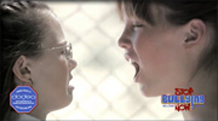Stop Bullying: For Administrators
Every child is entitled to feel safe in the classroom, hallways, or on the playground. In our schools, where so many of our students may have a parent deployed or may have experienced many transitions making them the "new kid" over and over, establishing a climate where bullying is never tolerated is even more important. DoDEA is committed to providing exceptional educational programs and this can only be accomplished when children feel safe, secure, and are happy in the hallways of our schools across the globe.
DoDEA is joining forces with the Departments of Health and Human Services, Education and Justice to empower parents and students to take a stand and lend a hand to stop bullying.
As educators, you know first-hand that bullying negatively affects the atmosphere of the school and disrupts the learning environment. Student achievement suffers among both the students who are bullied and those who engage in bullying.
In an atmosphere where bullying is tolerated, teacher morale declines which can interfere with discipline and learning. When students regularly witness bullying, they can begin to feel that the adults are not in control or are uncaring. And finally, parent confidence and trust in the school erodes when students experience bullying or are accused of bullying others.
Tips for Administrators
What can you do when bullying happens?
There is no set formula for the best way to intervene when you suspect or observe a bullying incident. You must consider a variety of issues, including the safety of all children, the age and gender of the children involved, the circumstances surrounding the bullying, the form and type of bullying, and the role of bystanders.
Here are some actions you may want to consider:
- Intervene immediately. Separate the students involved. Do not immediately ask about or discuss the reason for the bullying or try to sort out the facts.
- Request more information. Get the facts. Speak to students involved (participants and observers) in the incident separately and ask what happened.
- Tell the students you are aware of their behavior. Talk to the students involved separately.
- Make it a teachable experience. Helping bystanders understand what has happened and why may be important for preventing future incidents. Remember to:
- Report the incident to the right person (the school might consider identifying an official contact, who may be the school administrator, or a member of the school safety committee).
- Consider an appropriate intervention based on the severity and history of the incident and the students involved.
- Follow up with the students involved to ensure the bullying does not continue.
After a bullying incident, there's more you can do to prevent it from happening again.
For the Student Who Was Bullied
- Check in regularly with the student who was bullied
- Determine whether the bullying still continues
- Provide a supportive environment
- Review the school rules and policies with the student to ensure they are aware of their rights and protection
- Consider referring them for professional or other services as appropriate
For the Student Who Bullied Others
- Identify the behavior
- Review the school rules and policies with the student
- Ask for positive change in future behavior
- Consider referring them for professional or other services as appropriate
- Consider appropriate graduated consequences
- Encourage the student to channel their influence and behavior into positive leadership roles
- Monitor and check in frequently
For Bystanders
- Encourage them to talk with you
- Review the school rules and policies with the students
- Discuss with bystanders how they might intervene and/ or get help next time
- Acknowledge students who took action to stop the bullying
For the Parents of the Students Involved
- Describe the incident
- Review the school rules and policies with the parents
- Describe the intervention measures taken as appropriate
- Develop a plan to follow up
What else can be done to establish DoDEA schools as no bullying zones?
All school personnel including teachers, administrators, custodians, clerical staff and students and parents must work together as a "school community" to eliminate bullying and harassing behavior.
It is important to make clear that the school not only expects students not to bully, but that it also expects them to be good citizens, not passive bystanders, if they are aware of bullying or students who appear troubled, possibly from bullying. Developing simple, clear rules about bullying can help to ensure that students are aware of adults' expectations that they refrain from bullying and help students who are bullied. For example, one comprehensive program, the Olweus
Four rules about bullying:
- We will not bully others.
- We will try to help students who are bullied.
- We will make it a point to include students who are easily left out.
- If we know someone is being bullied, we will tell an adult at school and an adult at home.
School rules and policies should be posted and discussed with students and parents. Appropriate positive and negative consequences also should be developed for following or not following the school's rules.
Increase adult supervision in places where bullying has occurred or is likely to occur. Bullying tends to thrive in locations where adults are not present or are not vigilant.
DoDEA is committed to providing a safe and supportive learning environment for all students.


